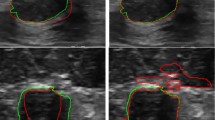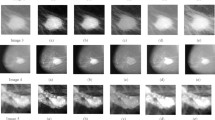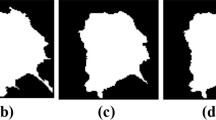Abstract
Image segmentation is an important step in image processing application, especially for medical images. It is also a very important task in breast cancer detection. There are various stages for breast cancer detection. The first stage is extraction/segmentation of region of interest followed by detection and classification. In this paper, a new clustering procedure is proposed to extract/segment the region of interest/lesion in mammogram images using neutrosophic set (NS). A variety of image segmentation algorithms are in the literature, but accuracy is still a crucial problem. NS has an ability to handle indeterminant information thus reducing the uncertainty in the images. The image is initially converted to an NS domain, which is described using three membership sets: degree of truth (T), degree of indeterminacy (I), and degree of false (F). In our work, indeterminate degree is computed using a novel technique that uses Shannon entropy and standard deviation. Then, a neutrosophic similarity-based image is formed using neutrosophic similarity function, which is then clustered to detect lesion/tumor. In the clustering algorithm, three image features and also a second criterion function, which is an exponential entropy, are used. The proposed algorithm has been tested on different types of mammogram images along with a comparative study with existing methods both quantitatively and qualitatively. The experimental results demonstrate that the proposed method can segment the mammogram images more effectively and accurately.





Similar content being viewed by others
Explore related subjects
Discover the latest articles, news and stories from top researchers in related subjects.Data Availability
A data availability statement is mandatory for publication in this journal. Please confirm that this statement is accurate, or provide an alternative.
References
Abualigah L, Diabat A (2021) Advances in sine cosine algorithms: a comprehensive survey. Artif Intell Rev 54:2567–2608
Abualigah L, Diabat A, Mirjalili S, Elaziz MA, Gandomi AH (2021) The arithmetic optimization algorithm. Comp Meth Appl Mech Eng. 376:113609
Abualigah L, Yousri A, Elaziz MA, Ewees AA, Alquaness MAA, Gandomi AH (2021) Aquila optimizer: a novel meta-heuristic optimization algorithm. Comp Industr Eng. 157:107250
Abualigah LMQ (2019) Feature selection and enhanced Krill Herd algorithm for text document clustering, Studies in Computational Intelligence 816, Springer International Publishing.
Ahmed M, Anter et al (2014) Neutrosophic sets and fuzzy C-means clustering for improving CT liver image segmentation. Proc, of The 5th International Conference on Innovations in Bio-Inspired Computing and Applications (Springer) IBICA2014, Ostrava, Czech Republic, 22–24 June.
Atanassov KT (1985) Intuitionistic Fuzzy Sets: Theory and Applications, Series in Fuzziness and Soft Computing, Phisica-Verlag, Heidelberg.
Chaira T (2011) A novel intuitionistic fuzzy c means clustering algorithm and its application to medical images. Appl Soft Comp. 11(2):1711–1717
Chaira T (2012) Intuitionistic fuzzy color clustering of human cell images on different color models. J Intell Fuzzy Syst. 23:43–51
Chaira T (2021) An intuitionistic fuzzy clustering approach for detection of abnormal regions in mammogram images. J Digital Imag. 34(2):1–12
Chaira T, Panwar A (2013) An Atanassov's intuitionistic Fuzzy Kernel Clustering for Medical Image segmentation. Int J Comput Intell Syst. 1–11
Das A, Sabut SK (2016) Kernelized fuzzy C-means clustering with adaptive thresholding for segmenting liver tumors. Procedia Comp Sci. 92:389–395
Dubey YK, Mushriff MM, Mitra K (2016) Segmentation of MR brain images using rough set based intuitionistic fuzzy clustering. Biocybern Biomed Eng. 36:413–426
Gonzalez RC, Woods RE (2009) Digital Image Processing, Pearson Education New Delhi, India
Guo Y, Cheng H (2009) A new neutrosophic approach to image segmentation. Pattern Recogn 42:587–595
Guo Y, Sengur A (2014) A novel segmentation algorithm based on neutrosophic similarity clustering. Appl Soft Comput 25:391–398
Guo Y, Sengur A (2015) NCM: Neutrosophic c means clustering algorithm. Pattern Recogn 48:2710–2724
Guo Y et al (2018) A novel skin lesion detection approach using neutrosophic clustering and adaptive region growing in dermoscopy images. Symmetry 10:119
Hassanien, Aboul Ella, Basha, Sameh, S. Abdalla, Areeg (2018) Generalization of fuzzy C-means based on neutrosophic logic, Studies in Informatics and Control 27(1)
Kannan SR et al (2010) Effective fuzzy c-means based kernel function for efficient segmenting medical images. Comp Biol Med 40:572–579
Kannan SR et al (2011) Robust kernel FCM in segmentation of breast medical images. Expert Syst Appl 38(2011):4382–4389
Karabatak E, Guo Y, Sengur A (2013) Modified neutrosophic approach to color image segmentation. J Electr Imag. 22(1):013005
Lal M et al (2018) Automatic segmentation of tumors in B-mode breast ultrasound images using information gain based neutrosophic clustering. J X Ray Sci Technol. 26(2):209–225
Shan J et al (2012) A novel segmentation method for breast ultrasound images based on neutrosophic l-means clustering. Med Phys 39(9):5669–5682
Smarandache S (2003) A unifying field in logic, neutrosophy, neutrosophic set, neutrosophc probabity, 3rd eds, American Research Press.
Verma H et al (2019) Modified intuitionistic fuzzy c means algorithm incorporating hesitation degree. Pattern Recogn Lett 122:45–52
Wang Z et al (2019) An image segmentation method based on improved Krill herd algorithm and fuzzy c means clustering algorithm, Proc. of IEEE Intl. Conference on Intelligent Data Acquisition and Advanced Computing Systems: Technology and Application, 18–21 Sept., France.
Yang MS, Tsai HS (2008) A Gaussian kernel-based fuzzy c-means algorithm with a spatial bias correction. Pattern Recogn Lett 29:1713–1725
Yasnoff LA et al (1977) Error measures for scene segmentation. Pattern Recogn 9:217–231
Ye J (2013) Multicriteria decision making method using the correlation coefficient under single valued neutrosophic environment. Int J Gen Syst 42(4):386–394
Zadeh LA (1965) Fuzzy sets, information. Control 8:338–435
Zhang L, Zhang M, Cheng HD (2010) A neutrosophic approach to image segmentation based on watershed method. Signal Process 90(5):510–1517
Zhang L, Zhang M, Cheng HD (2012) Color image segmentation based on neutrosophy. Opt Eng. 51(3):037003
Acknowledgments
The author would like to acknowledge the editor and anonymous reviewers for their valuable comments in improving the quality of the manuscript.
Funding
The authors have not disclosed any funding
Author information
Authors and Affiliations
Corresponding author
Ethics declarations
Conflict of interest
Author received no funding and declares that she has no conflict of interest.
Ethical approval
This article does not contain any studies with human participants or animals performed by the author.
Additional information
Publisher's Note
Springer Nature remains neutral with regard to jurisdictional claims in published maps and institutional affiliations.
Rights and permissions
About this article
Cite this article
Chaira, T. Neutrosophic set based clustering approach for segmenting abnormal regions in mammogram images. Soft Comput 26, 10423–10433 (2022). https://doi.org/10.1007/s00500-022-06882-7
Accepted:
Published:
Issue Date:
DOI: https://doi.org/10.1007/s00500-022-06882-7




